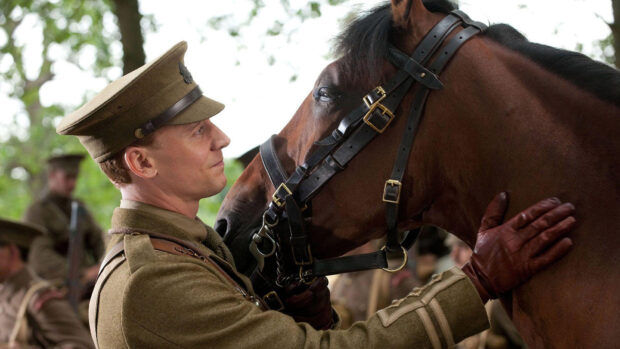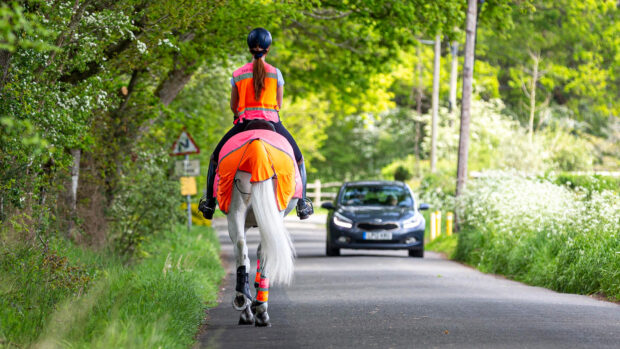You may associate the sport of equestrian vaulting – gymnastics on horseback – with the impressive displays given at shows, often in full costume. It’s actually an established sport in its own right, though, with roots going back thousands of years.
Originally used as a training exercise among athletes and cavalry riders for teaching balance and agility, it’s now growing in popularity as a sport, and is also used therapeutically to help improve focus, coordination and motor skills.
Rebecca Hewitt is a British Vaulting Association coach based in Scotland, who first started vaulting at the age of 11.
“I competed up until the age of 18, then began to coach and quickly turned to training the horses,” she says. “I’ve now been involved with the sport for 28 years.
“It’s all about learning to work in harmony with the horse, first of all on the ground, then at a walk and then at a canter. The aim is basically to do mounted gymnastics exercises, but at the beginning it’s often just about gaining confidence on and around a horse without actually having to be responsible for controlling it.
“The vaulters wear tight fitting clothing, and the horse wears a special large pad to protect their back and a roller with handles attached. It’s fantastic for improving confidence more than anything, but it is also brilliant for coordination and balance which crosses over into any other equestrian discipline.”

Talygarn Vaulters showing that the sport can be enjoyed by all ages
Chris Rogers is a vaulting coach and BHS instructor, and runs Talygarn Vaulters as part of her riding school in South Wales.
“Some of my vaulters came to the riding school initially, and were attracted to the vaulting we do here. Others saw displays or articles and came specifically to try vaulting. I think it appeals to those with a bit of a dare devil nature, but otherwise attracts people from a variety of different backgrounds.
“You only need to be averagely fit to start to learn the basics and have fun. If you want to progress or possibly compete, you will need greater strength and fitness – having a dance and gymnastic background can help there.
“From what I’ve seen as a riding school owner, I would say many people see riding as a form of exercise in its own right, and don’t think about exercising to become fit enough to ride. Experienced vaulters who also ride conventionally have high levels of fitness, core strength and balance, which helps them develop their riding skills to a much higher level.
“You can use any type of horse, especially when starting out, they just need an easy-going nature and an ability to walk steadily on the lunge. When progressing to canter, you need a horse with a slow and even canter on the lunge. Many vaulting horses are around the 17hh mark but that’s not essential, some of my young vaulters use a 14hh cob and my steadiest horse, used for our special needs group, is a 16hh part-bred Shire.”
Rebecca agrees. “Over the years I’ve trained all types of horses. The ones who take to it most are those who enjoy attention from people and are happy to take on new challenges. Having said that, some of my best horses have been unsuccessful in other disciplines, and they have taken to vaulting well.”
According to Chris, the sport is easy and safe at a beginner level.
“As with any equestrian discipline there’s a level of risk, which increases as you become more advanced, but we follow strict safety measures at all times,” she explains. “Although vaulters generally don’t wear hats, as they can become an impediment during the performance, novices and beginners are welcome to wear them if they feel happier to do so. Vaulting is a different mindset to other disciplines, as the horse is always controlled by the person on the ground and the vaulter is not a rider but a gymnast using moving apparatus.”
Rebecca adds: “To get a better idea of what’s involved, just come and see a vaulting group in action – it’s honestly the most fun youngsters can have. It’s so rewarding at the beginner level to see them learn to enjoy the movement of the horse and help each other to achieve little things.”
If you’d like to give it a go, most vaulting clubs hold taster sessions to encourage new members. These may be advertised locally or on social media, or visit the British Equestrian Vaulting website. Although equestrian vaulting is huge in Europe, it’s still fairly niche in the UK so if there isn’t a club near you, nag your local riding school to give it a try!

Want to give vaulting a try? 9 ways not to make a fool of yourself
If you've been inspired by the vaulting at the FEI European Championships in Aachen and are keen to give it

Why was event rider Oliver Townend wearing a purple tutu?
Oli has been trying his hand at vaulting to Jive Pony during the first leg of the popular Champions Tour

Subscribe to Horse & Hound magazine today – and enjoy unlimited website access all year round




